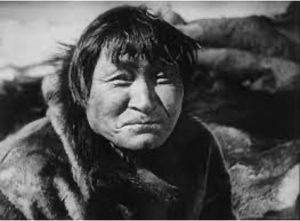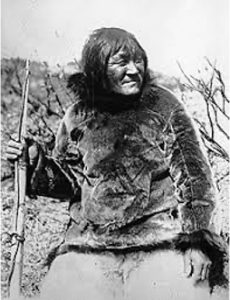AFI Catalog Spotlight: NANOOK OF THE NORTH
Celebrating 100 years since its theatrical release on June 11, 1922, NANOOK OF THE NORTH continues to be studied as pioneering yet problematic account of Inuit indigenous peoples living in Canada’s North Hudson Bay region at a time in which little was known about their culture. Over the century since its release, the film has been scrutinized for its deceptive mixture of documentary filmmaking and docudrama (a genre that was unheard of at the time), but NANOOK OF THE NORTH was nevertheless the first feature-length “documentary” to secure financial success at the box office, paving the way for future filmmakers, and was one of the first 25 films ever chosen by the Library of Congress’ National Film Registry for preservation in 1989.
 Director Robert Flaherty—who also served as writer, producer and director of photography—first became introduced to Inuit communities in 1910, when Sir William MacKenzie hired him to survey the Hudson Bay region for its economic potential. Aware that Inuit culture was threatened with extinction, Flaherty decided to apprentice as a camera operator between 1913 and 1914, where he “shot 30,000 feet of amateurish negative.” Over the next few years, Flaherty continued his work using more sophisticated equipment and showed the outcomes at test screenings (for the Inuit, who gave him notes), that were met with positive responses. In 1916, Flaherty accidentally ruined his film by dropping a lit cigarette on a negative, but he was not deterred, stating: “It saved the public a poor film.” Knowing the potential of the project, however, Flaherty decided to resume his work, this time focusing on one Inuit family lead by “Nanook” (who was, in actuality, named Allakariallak). After years of seeking financial backing, Flaherty secured funding from a fur company called Revillon Freres and resumed shooting from August 1920 to August 1921 at a Revillon fur trading post at Cape Dufferin, on the northeastern side of Hudson Bay.
Director Robert Flaherty—who also served as writer, producer and director of photography—first became introduced to Inuit communities in 1910, when Sir William MacKenzie hired him to survey the Hudson Bay region for its economic potential. Aware that Inuit culture was threatened with extinction, Flaherty decided to apprentice as a camera operator between 1913 and 1914, where he “shot 30,000 feet of amateurish negative.” Over the next few years, Flaherty continued his work using more sophisticated equipment and showed the outcomes at test screenings (for the Inuit, who gave him notes), that were met with positive responses. In 1916, Flaherty accidentally ruined his film by dropping a lit cigarette on a negative, but he was not deterred, stating: “It saved the public a poor film.” Knowing the potential of the project, however, Flaherty decided to resume his work, this time focusing on one Inuit family lead by “Nanook” (who was, in actuality, named Allakariallak). After years of seeking financial backing, Flaherty secured funding from a fur company called Revillon Freres and resumed shooting from August 1920 to August 1921 at a Revillon fur trading post at Cape Dufferin, on the northeastern side of Hudson Bay.
 During this time, Flaherty famously staged events but presented them as reality, sometimes for comedic effect such as a scene in which “Nanook” tries to take a bite out of a gramophone record for food, all the while knowing exactly what it was. Sets were constructed to accommodate large cameras, including a special three-walled igloo. Characters were made to seem more ignorant of modern culture that they actually were; while “Nanook” typically hunted with a gun, for example, Flaherty directed him to hunt in the ways of his ancestors to make the Inuit appear less technologically advanced. In addition, “Nanook’s” two onscreen wives were indeed Flaherty’s own common-law wives; one of whom (“Nyla”) bore Flaherty a son named Josephie, who never met his father. Josephie was eventually adopted by Paddy Aqiatusuk, a renowned soapstone sculptor who married “Nyla.” The 1990 documentary NANOOK REVISITED traveled to Inukjuak, Quebec, where much of Flaherty’s film was shot, and discovered that Flaherty’s picture consisted mainly of reenactments. Years later, Josephie’s daughter, Martha Flaherty, became the subject of a Canadian documentary titled MARTHA OF THE NORTH (2008), which examined the atrocities her family suffered in 1953 when the Canadian government forced Paddy Aqiatusuk and 87 Inuits to move further north to Ellsemere Island, where they struggled to survive in the harsh climate. “Nanook” himself died two years after the release of NANOOK OF THE NORTH, and while Flaherty claimed the cause of death was starvation, it was likely a result of tuberculosis which was contracted through his contact with foreigners such as Flaherty.
During this time, Flaherty famously staged events but presented them as reality, sometimes for comedic effect such as a scene in which “Nanook” tries to take a bite out of a gramophone record for food, all the while knowing exactly what it was. Sets were constructed to accommodate large cameras, including a special three-walled igloo. Characters were made to seem more ignorant of modern culture that they actually were; while “Nanook” typically hunted with a gun, for example, Flaherty directed him to hunt in the ways of his ancestors to make the Inuit appear less technologically advanced. In addition, “Nanook’s” two onscreen wives were indeed Flaherty’s own common-law wives; one of whom (“Nyla”) bore Flaherty a son named Josephie, who never met his father. Josephie was eventually adopted by Paddy Aqiatusuk, a renowned soapstone sculptor who married “Nyla.” The 1990 documentary NANOOK REVISITED traveled to Inukjuak, Quebec, where much of Flaherty’s film was shot, and discovered that Flaherty’s picture consisted mainly of reenactments. Years later, Josephie’s daughter, Martha Flaherty, became the subject of a Canadian documentary titled MARTHA OF THE NORTH (2008), which examined the atrocities her family suffered in 1953 when the Canadian government forced Paddy Aqiatusuk and 87 Inuits to move further north to Ellsemere Island, where they struggled to survive in the harsh climate. “Nanook” himself died two years after the release of NANOOK OF THE NORTH, and while Flaherty claimed the cause of death was starvation, it was likely a result of tuberculosis which was contracted through his contact with foreigners such as Flaherty.
NANOOK OF THE NORTH remains “arguably the most famous film ever shot in Canada,” as stated in the “Canadian Encyclopedia.” It was a commercial success upon its release in June 1922 and audiences flocked to witness the Inuit’s masterful survival in the natural world. While its claim to being the first feature length documentary is questionable, it was a work of great innovation. Reflecting upon his relationship with the subject of his film, Robert Flaherty wrote in the introductory title cards: “This experience gave me an insight into their lives and a deep regard for them.”